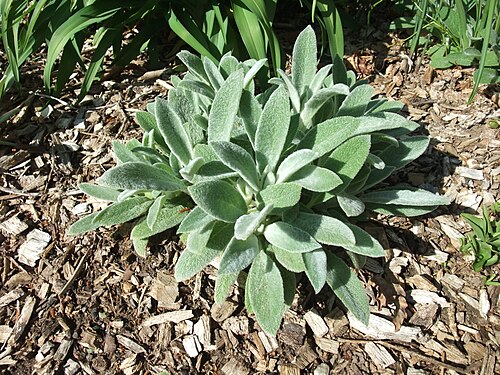Stachys byzantina
| Habit | herbaceous
| |
|---|---|---|
| Height: | ⇕ | 18 in"in" can not be assigned to a declared number type with value 18. |
| Width: | ⇔ | 24 in"in" can not be assigned to a declared number type with value 24. |
| Lifespan: | ⌛ | perennial |
| Bloom: | ❀ | early spring, mid spring, late spring, early summer, mid summer, late summer |
| Exposure: | ☼ | sun |
|---|---|---|
| Features: | ✓ | flowers, ground cover, fire resistant |
| USDA Zones: | 4 to 8 | |
| Flower features: | ❀ | red, blue, purple, pink |
|
Stachys > |
Stachys byzantina (syn. S. lanata; Lamb's-ear or Lamb's Ear) is a species of Stachys, native to Turkey, Armenia, and Iran.[1][2] It is cultivated over much of the temperate world as an ornamental plant, and is naturalised in some locations as an escape from gardens. Plants are very often found under the synonym Stachys lanata or Stachys olympica.
Lamb's Ear flowers in late spring and early summer, plants produce tall spike-like stems with a few reduced leaves. The flowers are small and either white or pink. The plants tend to be evergreen but can "die" back during cold winters and regenerate new growth from the crowns. In warmer climates they may grow year-round, but suffer where it's hot and humid. They are easy to grow, preferring partial shade to full sunlight and well-drained soils not rich in nitrogen.
Perennial herbs usually densely covered with gray or silver-white, silky-lanate hairs. They are named lambs ears because of the curved shape and white, soft, fur like hair coating. Flowering stems are erect, often branched, and tend to be 4-angled, growing 40-80 cm tall. The leaves are thick and somewhat wrinkled, densely covered on both sides with gray-silver colored, silky-lanate hairs, the under sides more silver-white in color than the top surfaces. The leaves arranged oppositely on the stems and 5 to 10 cm long. Leaf petioles semiamplexicaul (the bases wrapping half way around the stem) with the basal leafs having blades oblong-elliptic in shape, measuring 10 cm long and 2.5 cm wide (though variation exists in cultivated forms), The leaf margins are crenulate but covered with dense hairs, the leaf apexs attenuate, gradually narrowing to a rounded point. The flowering spikes are 10-22 cm long, producing verticillasters that each have many flowers and are crowded together over most of the length on the spike-like stem. The leaves produced on the flowering stems are greatly reduced in size and subsessile, the lower ones slightly longer than the verticillasters and the upper ones shorter than the verticillasters. Leaf bracteoles linear to linear-lanceolate in shape and 6 mm long. The flowers have no pedicels (sessile) and the calyx is tubular-campanulate in shape, being slightly curved and 1.2 cm long. The calyx is glabrous except for the inside surface of the teeth, having 10-veins with the accessory veins inconspicuous. The 2-3 mm long calyx teeth are ovate-triangular in shape and are subequal or the posterior teeth larger, with rigid apices. Corollas with some darker purple tinted veins inside, 1.2 cm long with silky-lanate hairs but bases glabrous. The corolla tubes are about 6 mm long with the upper lip ovate in shape with entire margins; the lower lips are subpatent with the middle lobe broadly ovate in shape, lateral lobes oblong. The stamen filaments are densely villous from the base to the middle. Styles much exserted past the corolla. Immature nutlets with out hairs, brown in color and oblong in shape.[3][4]
Cultivated over much of the temperate parts of the world and naturalized in some locations as an escape from gardens.
Lamb's Ear is a commonly grown plant for children's gardens or used as an edging plant, as they are easy to grow and the thick felt like leaves are fun to touch. It has sometimes been used as a medicinal plant.
Cultivation
Propagation
Pests and diseases
Varieties
A number of cultivars exist including white flowering forms, plants with shorter habit and plants that do not bloom as much.
- 'Big Ears' - leaves very large, up to 25 cm long.
- 'Cotton Ball' - a sterile cultivar that does not produce flowering stems. Asexually propagated.
- 'Primrose Heron' - leaves yellow in spring; flowers pink
- 'Sheila Macqueen' - sterile; low-growing; leaves large.
- 'Silky Fleece' - grows 25 cm tall with lilac-plum flowers, produce smaller white-woolly foliage. Seed propagated.
- 'Silver Carpet' - sterile; leaves grey. Asexually propagated.
- 'Striped Phantom' - leaves variegated.
Gallery
References
- ↑ Euro+Med Plantbase: Stachys byzantina
- ↑ Huxley, A., ed. (1992). New RHS Dictionary of Gardening. Macmillan ISBN 0-333-47494-5.
- ↑ Stachys lanata in Flora of China @ efloras.org
- ↑ Stachys byzantina page
External links
- w:Stachys byzantina. Some of the material on this page may be from Wikipedia, under the Creative Commons license.
- Stachys byzantina QR Code (Size 50, 100, 200, 500)





